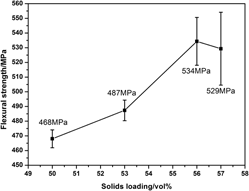Crossref Citations
This article has been cited by the following publications. This list is generated based on data provided by
Crossref.
Sun, Yi
Shimai, Shunzo
Peng, Xiang
Zhou, Guohong
Kamiya, Hidehiro
and
Wang, Shiwei
2014.
Fabrication of transparent Y2O3 ceramics via aqueous gelcasting.
Ceramics International,
Vol. 40,
Issue. 6,
p.
8841.
Yang, Yan
and
Wu, Yiquan
2014.
Tape-casted transparent alumina ceramic wafers.
Journal of Materials Research,
Vol. 29,
Issue. 19,
p.
2312.
Peng, Xiang
Shimai, Shunzo
Sun, Yi
and
Wang, Shiwei
2015.
Effect of temperature difference on presintering behavior of gelcast thick alumina bodies.
Ceramics International,
Vol. 41,
Issue. 5,
p.
7151.
Peng, Xiang
Shimai, Shunzo
Sun, Yi
Zhou, Guohong
and
Wang, Shiwei
2015.
Correlation between microstructure evolution and drying behavior of gelcast alumina green bodies.
Ceramics International,
Vol. 41,
Issue. 9,
p.
11870.
Deng, Xiangong
Wang, Junkai
Liu, Jianghao
Zhang, Haijun
Li, Faliang
Duan, Hongjuan
Lu, Lilin
Huang, Zhong
Zhao, Wanguo
and
Zhang, Shaowei
2015.
Preparation and characterization of porous mullite ceramics via foam-gelcasting.
Ceramics International,
Vol. 41,
Issue. 7,
p.
9009.
Zhang, Peipei
Liu, Peng
Sun, Yi
Wang, Jun
Wang, Zhengjuan
Wang, Shiwei
and
Zhang, Jian
2015.
Aqueous gelcasting of the transparent MgAl2O4 spinel ceramics.
Journal of Alloys and Compounds,
Vol. 646,
Issue. ,
p.
833.
Sun, Yi
Shimai, Shunzo
Peng, Xiang
Zhou, Guohong
and
Wang, Shiwei
2015.
Gelcasting and vacuum sintering of translucent alumina ceramics with high transparency.
Journal of Alloys and Compounds,
Vol. 641,
Issue. ,
p.
75.
Yang, Yan
Wei, Hua
Zhang, Lihua
Kisslinger, Kim
Melcher, Charles L.
and
Wu, Yiquan
2015.
Blue emission of Eu2+-doped translucent alumina.
Journal of Luminescence,
Vol. 168,
Issue. ,
p.
297.
Yang, Yan
and
Wu, Yiquan
2015.
Environmentally benign processing of YAG transparent wafers.
Optical Materials,
Vol. 50,
Issue. ,
p.
32.
Zhang, Peipei
Liu, Peng
Sun, Yi
Peng, Xiang
Wang, Zhengjuan
Wang, Shiwei
and
Zhang, Jian
2016.
Microstructure and properties of transparent MgAl 2 O 4 ceramic fabricated by aqueous gelcasting.
Journal of Alloys and Compounds,
Vol. 657,
Issue. ,
p.
246.
Sun, Yi
Peng, Xiang
Shimai, Shunzo
Zhou, Guohong
and
Wang, Shiwei
2016.
Improved Strength of Alumina Ceramic Gel and Green Body Based on Addition‐Esterification Reaction.
International Journal of Applied Ceramic Technology,
Vol. 13,
Issue. 6,
p.
1159.
Yang, Yan
Liu, Yin
Shimai, Shunzo
and
Wu, Yiquan
2016.
Green and Sustainable Manufacturing of Advanced Material.
p.
497.
Zhang, Jian
Sun, Yi
Shimai, Shunzo
Peng, Xiang
Zhao, Jin
Zhou, Guohong
and
Wang, Shiwei
2017.
Effect of TMAH on the rheological behavior of alumina slurries for gelcasting.
Journal of Asian Ceramic Societies,
Vol. 5,
Issue. 3,
p.
261.
Zhang, Xiaodong
Hao, Junjie
Guo, Zhimeng
Ji, Zhenhui
Luo, Ji
Chen, Cunguang
Yang, Fang
and
Volinsky, Alex A.
2018.
The Improved Thermal Conductivity of a Potting Material for High-Power Fast Warm-Up Cathodes.
Journal of Materials Engineering and Performance,
Vol. 27,
Issue. 12,
p.
6701.
Lu, Zhongliang
Miao, Kai
Zhu, Weijun
Chen, Yi
Xia, Yuanlin
and
Li, Dichen
2018.
Fractions design of irregular particles in suspensions for the fabrication of multiscale ceramic components by gelcasting.
Journal of the European Ceramic Society,
Vol. 38,
Issue. 2,
p.
671.
Lu, Yuju
Gan, Ke
Huo, Wenlong
Lv, Lin
Liu, Jingjing
Zhang, Xiaoyan
Yan, Shu
and
Yang, JinLong
2018.
Dispersion and gelation behavior of alumina suspensions with Isobam.
Ceramics International,
Vol. 44,
Issue. 10,
p.
11357.
Moorehead, Carli A
Blair, Victoria L
and
Sietins, Jennifer M
2018.
Proceedings of the 41st International Conference on Advanced Ceramics and Composites.
Vol. 38,
Issue. ,
p.
183.
Di, Zhengxian
Shimai, Shunzo
Zhao, Jin
Mao, Xiaojian
Zhang, Jian
Zhou, Guohong
Liu, Juan
and
Wang, Shiwei
2019.
Dewatering of spontaneous-coagulation-cast alumina ceramic gel by filtrating with low pressure.
Ceramics International,
Vol. 45,
Issue. 10,
p.
12789.
Hooshmand, Saleh
Nordin, Jan
and
Akhtar, Farid
2019.
Porous alumina ceramics by gel casting: Effect of type of sacrificial template on the properties.
International Journal of Ceramic Engineering & Science,
Vol. 1,
Issue. 2,
p.
77.
Yamamoto, Masahiro
Shimai, Shunzo
Oguma, Kazuki
Wang, Shiwei
and
Kamiya, Hidehiro
2019.
Alumina particle surface interaction in copolymer of isobutylene and maleic anhydride aqueous solution characterized by colloidal probe atomic force microscopy.
Powder Technology,
Vol. 354,
Issue. ,
p.
369.



